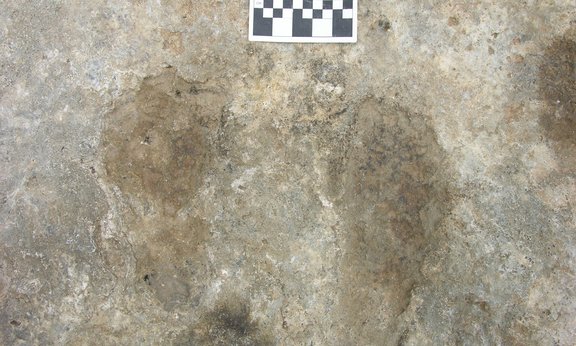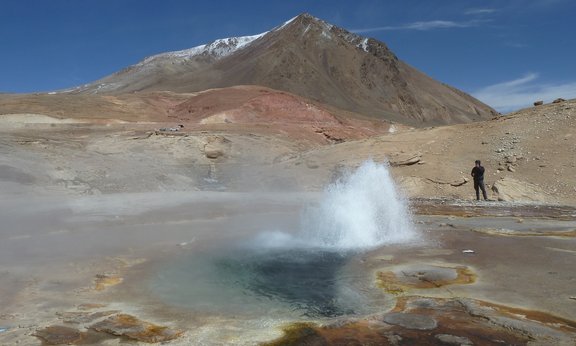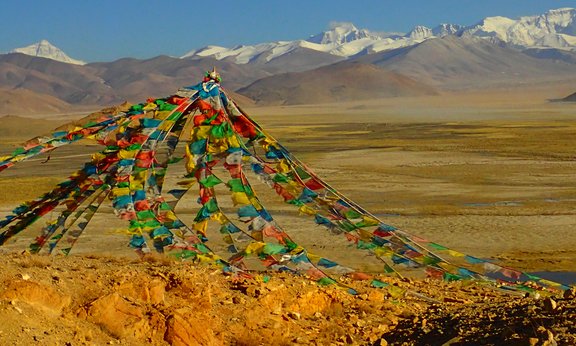The environmental conditions on the Tibetan Plateau, also known as the “Roof of the World“, pose considerable challenges to human adaptation. Because of the extreme elevation and remoteness, the plateau might have been one of the last regions on earth settled by humans. Michael Meyer, in collaboration with an international team of researchers, reanalyzed hand- and footprints preserved on the surface of a fossil hot spring carbonate and provided the first robust age estimate for these human traces: The data suggests that the imprints in Chusang are between 8,000 and 12,000 years old. This is the oldest evidence of permanent human occupation on the high-elevation step of the Tibetan Plateau. A previous attempt to date the same imprints estimated that they were 20,000 years old, which means from the last glacial maximum. At that time, Tibet was extremely arid and cold, which makes permanent human occupation unlikely. “This initial dating was highly contested among experts. But at the same time it was a first and important attempt to date a methodologically challenging geological material,” explains Meyer. By using several dating techniques, his research team was now able to securely constrain the age of the imprints. The data supports the presence of an early permanent population in the high mountains of the plateau. Several researchers participated in the study: Mark Aldenderfer from the University of California; Zhijun Wang from the University of Innsbruck; Dirk Hoffmann from the Max Planck Institute for Evolutionary Anthropology, Department of Human Evolution; Jennifer Dahl from the National Isotope Center, New Zealand; Detlev Degering from ADD Ideas Albrecht and Detlev Degering in Dresden, Germany; Randy Haas from the University of Wyoming and Frank Schlütz from the Lower Saxony Institute for Historical Coastal Research, Germany.

Trapped light
Chusang is located in the central part of Tibet and about 300 km north of the High Himalaya that forms the border range of the Plateau in the south. Because the Tibetan Plateau is tectonically active, it is also characterized by the occurrence of many young geological faults. Hot springs precipitating carbonate, also called travertine, are often bound to these geological structures. The tributary valley of Chusang, where the imprints were found, is covered with a travertine deposit that attains a thickness of several meters. Today you can still see the hand- and footprints these early Tibetans left on the travertine surface, which would have been soft carbonate and mud many millennia ago. “These findings are extremely rare and we are lucky that the imprints are still preserved. We knew that by dating the travertine layer that hosts the fossil imprints we would also be able to constrain the time of human presence at Chusang,” says Meyer. In addition to the conventional radiocarbon and uranium/thorium dating techniques, the researchers also used optically stimulated luminescence (OSL) dating. “This method is directly constraining the age of the sediment by determining how much luminescence, or in other words, how much light is trapped in the mineral,” explains Meyer. Minerals, such as quartz grains, have the ability to store energy that originates from the decay of naturally occurring radioisotopes (such as U, Th or K) at defects in their crystal lattice. Upon sediment burial quartz grains are exposed to environmental radioactivity and the longer these grains are buried the more energy they accumulate. “We can probe these tiny amounts of energy that are stored in individual quartz grains in our laboratory via optical stimulation and, thereby, determine the sediment age. Our expertise here in Innsbruck is to measure hundreds or thousands of individual sand-sized mineral grains using laser stimulation. With this method we can provide refined age estimates in complex sedimentary settings,” says Meyer. The OSL data from thousands of individual quartz grains in combination with the other dating techniques strongly suggest that the imprints are between 8,000 and 12,000 years old. This age estimate coincides with the early Holocene, i.e. the start of the current interglacial period. “In the context of Asia – including central High Asia and Tibet – the early Holocene is known for its wet and humid climatic conditions. Our data, thus, indicate that these initial hunter-gatherers moved onto the Plateau because the flora was lush and the fauna expanding.” The imprints in the travertine are not an entirely new discovery, however: The local Tibetans believe that the hand- and footprints were left by Guru Rinpoche, a Buddhist master who brought Buddhism to Tibet, and are, therefore, holy to the Tibetans. They are worshipped by many pilgrims every day.

Seasonal settlements unlikely
The average elevation of the central Tibetan Plateau is 4,500 meters above sea level. Meyer mentions the Mont Blanc with an elevation of 4,810 meters as a comparison. “Today we have a relatively good knowledge of how and when our ancestors migrated out of Africa and colonized the planet. We know with certainty that Tibet was one of the last places on earth where humans ventured into. The people had to deal with considerable physio-geographical challenges and genetically adapt to the extreme elevation to be able to colonize the central Tibetan Tableau,” explains Meyer, who also collaborated with a team of archeologists. Considering the difficulties in peopling this area, another aspect of the study deals with whether it would have been possible to reach the Chusang area just for seasonal hunting forays. Using travel cost modeling, Meyer’s colleagues Mark Aldenderfer and Randy Haas have shown that forays made onto the plateau just for the summer season would have been too far and arduous. “Since the hand- and footprints clearly show that children were part of the group, it would have been impossible to move back to lower regions for winter in due time,” explains archeologist Aldenderfer, underlining their suggestion that the Chusang site indicates permanent peopling of the plateau. Living permanently at this elevation requires humans to adapt, which even resulted in the development of specific genes that protect the body from hypoxia - these can only be found in Tibetans. Some geneticists even suggest that some of these mutations already started 30,000 years ago. Meyer agrees that it is possible that the oldest evidence of prehistoric humans settling the Tibetan Plateau may not have been found yet. Until then, however, the dating of the hand- and footprints of Chusang represents a milestone in the study of the peopling of the “Roof of the World”.

